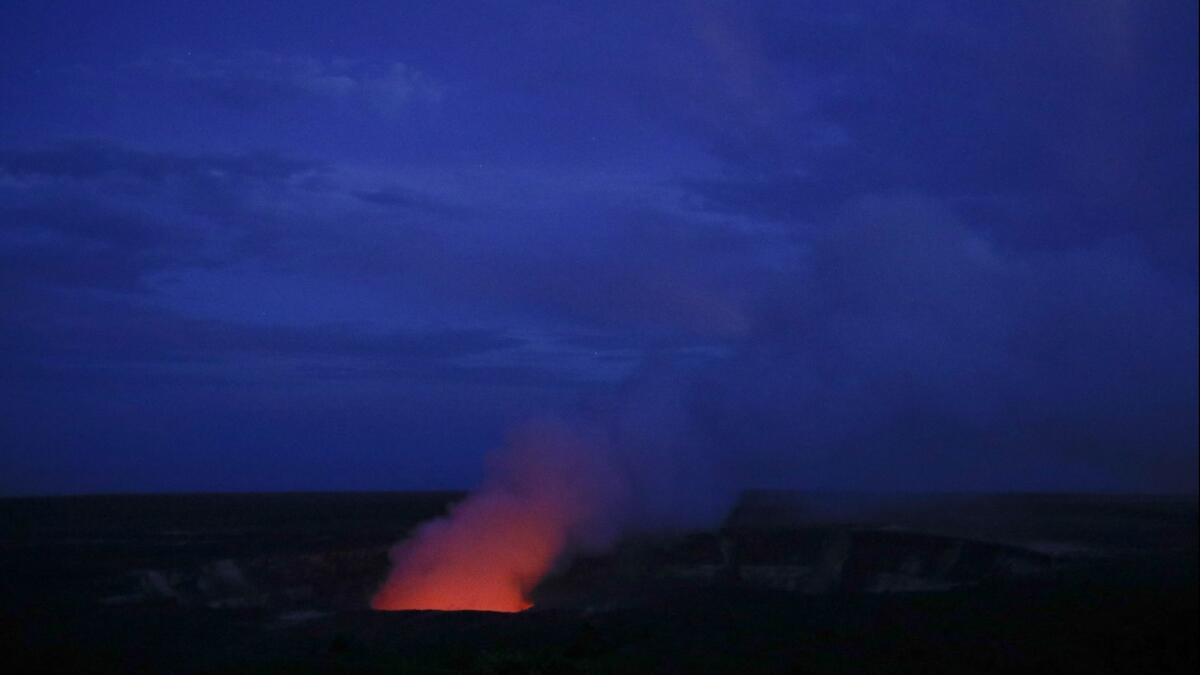Op-Ed: When lava erupts in your backyard, consider it a message from Pele

- Share via
The windward side of the Big Island of Hawaii doesn’t have the resorts of Maui or the Waikiki notoriety of Honolulu. Hilo, population 43,000, is not generally a destination. When my hometown shows up on the world’s news tickers, it’s because a disaster is on its way — a hurricane or a tsunami, or this week, the earth cracking open and spilling out lava in the middle of a nearby subdivision.
Since I moved to Los Angeles from Hilo, I can only watch from afar. If it’s a hurricane, I know my father will treat the sirens as a sign to head for the rocking chair he keeps in his yard, at the edge of the beach — a front row seat for the show. When the ash started flying 10 days ago, I couldn’t get through to my mother. She divorced my father years ago and lives in the town of Volcano, on the edge of the currently erupting Kilauea. (As it turns out, Volcano wasn’t evacuated, but my mom was off-island anyway, and safe.)
I’ve been glued to my phone, devouring news feeds and checking Facebook posts, watching friends and family helping each other to safety, grappling with what happens when your backyard unexpectedly explodes. Meanwhile, Fox News reported: “Oahu residents evacuated.”
I’m used to some confusion about my home state, but folks, Hawaii is made up of eight major islands. Oahu is one. The Big Island is another. There are no active volcanoes on Oahu. But on the Big Island, home of Volcanoes National Park, Kilauea has been constantly erupting since 1983. Not that lava spilling into our streets is normal. In my lifetime, it’s mostly been where people and homes aren’t. Obviously, there are no guarantees.
When fissures last opened, local kids wrote notes to her and tied them with ribbons to the chain-link fence of their evacuated school playground.
In the 1990s, a major lava flow disrupted what’s called the East Rift Zone and took out the beach where my mother and father got married. I considered it a message from Pele, goddess of the volcanoes, the creator of our island chain. My mother is part Filipino, part Portuguese, part Puerto Rican — a pinch of this, a smidge of that — a local. My father is from California, a haole. Depending on whom you ask, Pele might have had a negative opinion about that.
My father surfed his way over from Venice Beach and has never left. Try as he might to ingratiate himself in the community, throwing himself headfirst into every beer bottle and onto every fishing boat, he is white, a mainlander, and that means there’s no becoming truly local. (That happy ending in the cult movie “North Shore,” where the kid from Arizona gets accepted by Da Hui once he learns the art of soul surfing? It only happens in Hollywood.)
My mother was born on Kauai (see — another island), grew up on Oahu and has spent much of her adulthood on the Big Island. She was homecoming queen, voted most likely to marry quickly and have a dozen babies. She ached to escape but was the eldest of five, and a girl, and therefore she wasn’t allowed to go very far.
As their only child — with fair skin, blue eyes and burnt-red hair — I was both a local and an outsider, someone who was told to go back where I came from, but someone who had never been anywhere else. I learned to tread lightly. I got dragged around in a shirt that read: “I am NOT a tourist, I live here.” I cut my feet on the sharp volcanic edges of Pele’s smoking craters, dancing hula.
I’m local enough to know you don’t fight Pele. When fissures last opened, local kids wrote notes to her and tied them with ribbons to the chain-link fence of their evacuated school playground. Newcomers, people who had moved in from places where they were used to exerting some influence over their environment, suggested using bulldozers to dig trenches to divert the lava to less populated areas. We laughed. Pele was going to go where she wanted. Hawaii was her island. She gave birth to it. Who were we to tell her where she could go?
Here’s what newcomers have to learn: Never turn your back to the ocean. And never disrespect Pele. A few months after I first got my driver’s license, my car stalled near Kilauea’s Halema’uma’u Crater in the park. I called home for help. Instead of suggesting AAA, my mother told me to get my okole over to the crater to give Pele my regards. I did as directed, and when I returned, my vehicle started right up.
Now it looks like Pele’s in no mood for propitiation. The people I know on the Big Island aren’t waiting forFEMA to show up to save them. My ex-husband’s sister is running an evacuation center in her garage. My mom is hoping the ash hasn’t compromised her drinking water and the earthquakes haven’t damaged the tank. Everyone is dealing with events as they come, preparing to adjust to their altered landscape.
I’m still glued to my phone, watching. My fear and concern are laced with respect and reverence. The pictures — magnificent, frightening — don’t lie. What the locals know, what I was taught as a child, is true: When Pele rises, you don’t have a choice. Take a step back and bow your head.
Jasmin Iolani Hakes is working on a memoir about her Hawaii childhood.
Follow the Opinion section on Twitter @latimesopinion and Facebook.
More to Read
A cure for the common opinion
Get thought-provoking perspectives with our weekly newsletter.
You may occasionally receive promotional content from the Los Angeles Times.






